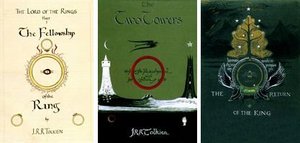The Lord of the Rings
The Lord of the Rings is an epic high fantasy saga by British author J. R. R. Tolkien, his magnum opus and a sequel to his well-received earlier work, The Hobbit. The Lord of the Rings was originally published in three volumes in 1954 and 1955. Three film adaptations have been made of the story told by the books: the first, by animator Ralph Bakshi was released in 1978 (as part one of what was intended to be a two-part adaptation of the story); the second, a 1980 television special; and the third, director Peter Jackson's epic film trilogy, released in three installments in 2001, 2002, and 2003 which starred Elijah Wood as the main character of Frodo. more...
For more information regarding the fictional universe in which the story takes place, including lists of characters and locations, see Middle-earth (the name Tolkien bestowed upon his world).
The titular character of the Lord of the Rings is the Dark Lord Sauron, ruler of the land of Mordor. The evil power of the work, Sauron created the One Ring to control nineteen other Rings of Power, and was thus the "Lord of the Rings." Sauron, in turn, was the servant of an earlier Dark Lord, Morgoth (Melkor), who is prominent in Tolkien's The Silmarillion, an earlier history of Middle-Earth.
Books and volumes
Writing
Tolkien did not originally intend to write a sequel to The Hobbit, and instead wrote several other children's tales, including Roverandom and Farmer Giles of Ham. As his main work, Tolkien began to outline the history of Arda, telling tales of the Silmarils, and many other stories of how the races and situations that we read about in the Lord of the Rings trilogy came to be. Tolkien died before he could complete and put together The Silmarillion, but his son Christopher Tolkien edited his father's work, filled in gaps, and published it in 1977.
Tolkien had a deep desire to write a mythology for England, especially after his horrific experiences during the First World War. Thus to understand his writings we must be aware of how Tolkien the scholar influences Tolkien the author. His writing of this mythology emerges as an Oxford philologist well acquainted with Northern European Medieval Literature including the great mythic works such as the Hervarar saga, the Völsunga saga, the influential Beowulf as well as other Old Norse, Old and Middle English Texts. He was also inspired by non-Germanic works such as the Finnish epic Kalevala. A man who had created his first language by the age of seven, he was driven by a desire to write a mythology for England influenced by his exposure and expertise of these ancient traditions. The need for such a myth was often a topic of conversation in his meetings with the Inklings, fellow Oxford scholars who have been described as Christian Romantics, meeting weekly and discussing Icelandic myths and their own unpublished compositions. Tolkien agreed with one of the other members of the group, C.S. Lewis, that if there were no adequate myths for England then they would have to write their own. Tolkien's work has been commonly interpreted in this light.
Persuaded by his publishers, he started 'a new Hobbit' in December 1937. After several false starts, the story of the One Ring soon emerged, and the book mutated from being a sequel to the Hobbit, to being, in theme, more a sequel to the unpublished Silmarillion. The idea of the first chapter (A Long-Expected Party) arrived fully-formed, although the reasons behind Bilbo's disappearance, the significance of the Ring, and the title The Lord of the Rings did not arrive until the Spring of 1938. Originally, he planned to write another story in which Bilbo had used up all his treasure and was looking for another adventure to gain more; however, he remembered the ring and its powers and decided to write about it instead. He began with Bilbo as the main character but decided that the story was too serious to use the fun-loving Hobbit and so Tolkien looked to use a member of Bilbo's family. He thought about using Bilbo's son but this generated some difficult questions — Where was his wife? How could Bilbo let his son go into that kind of danger? — so he looked for an alternate character to carry the ring. In Greek legend, it was a hero's nephew that gained the item of power, and so into existence came the Hobbit Frodo.
Writing was slow due to Tolkien's perfectionism, and was frequently interrupted by his obligations as an examiner, and other academic duties. The first sentence of The Hobbit was in fact written on a blank page which a student had left on an exam paper which Tolkien was marking — "In a hole in the ground there lived a Hobbit". He seems to have abandoned the book during most of 1943 and only re-started it in April 1944. This effort was written as a serial for Christopher Tolkien and C.S. Lewis — the former would be sent copies of chapters as they were written while he was serving in Africa in the Royal Air Force. He made another push in 1946, and showed a copy of the manuscript to his publishers in 1947. The story was effectively finished the next year, but Tolkien did not finish revising earlier parts of the work until 1949.
Read more at Wikipedia.org



